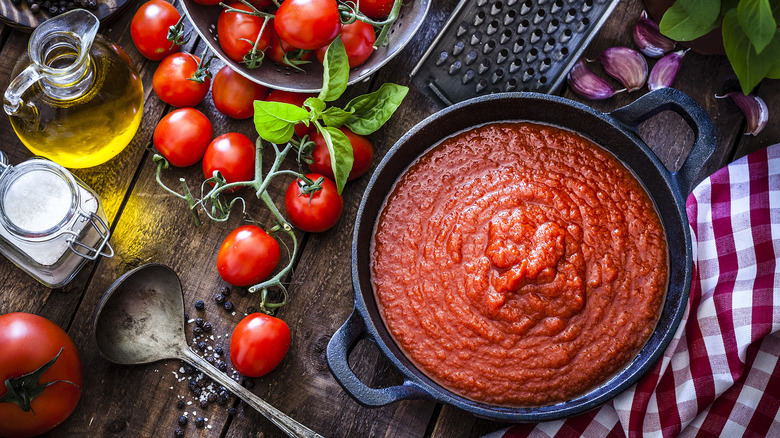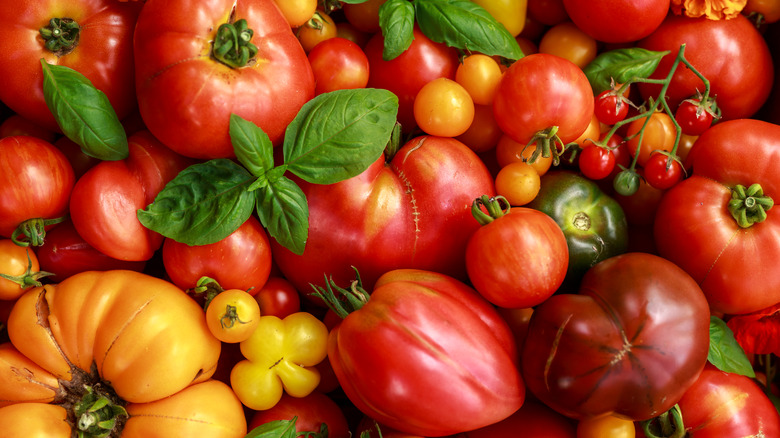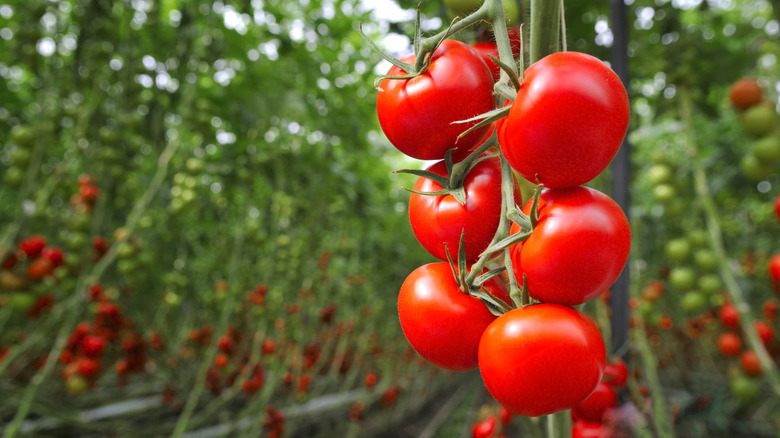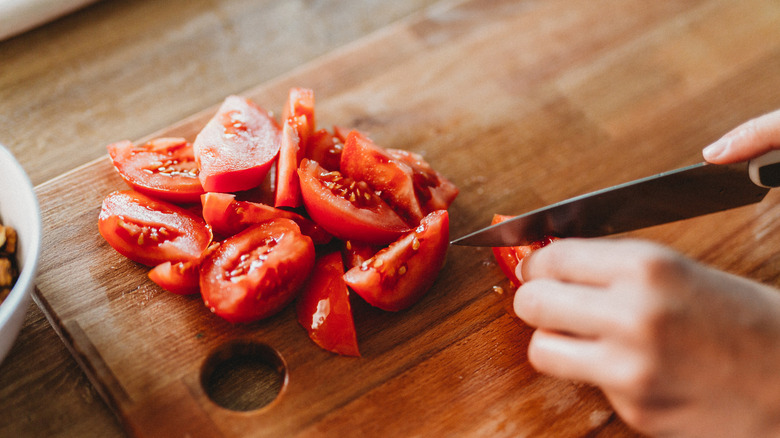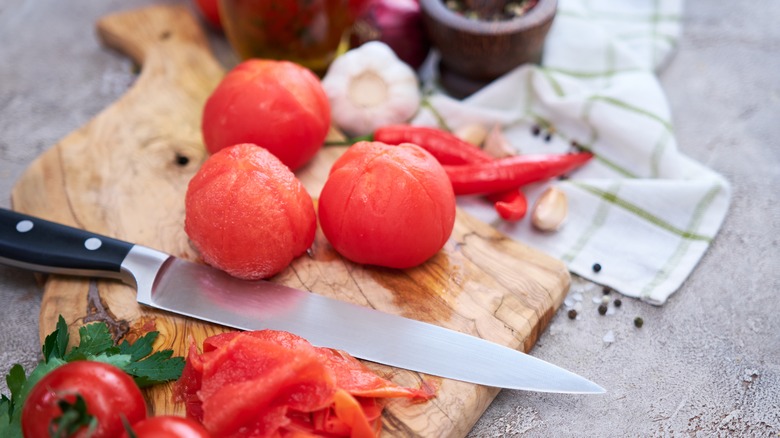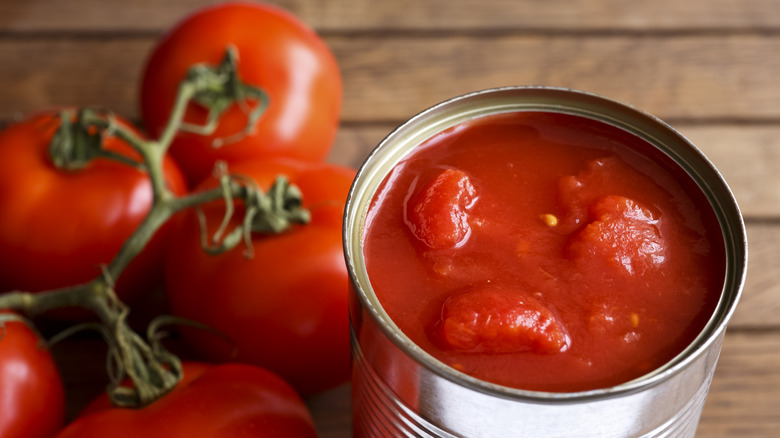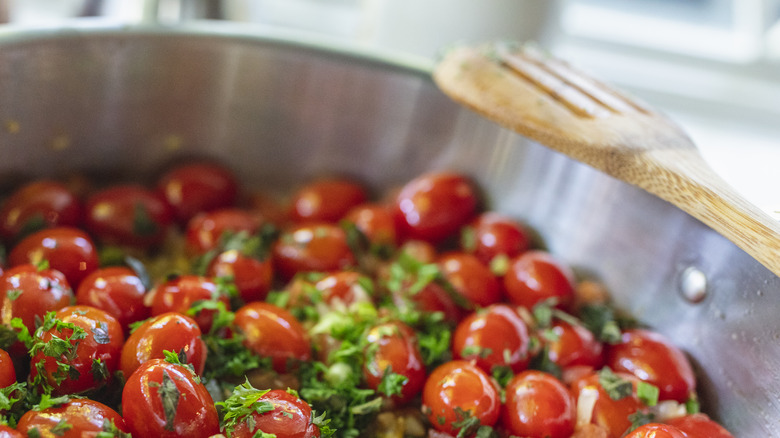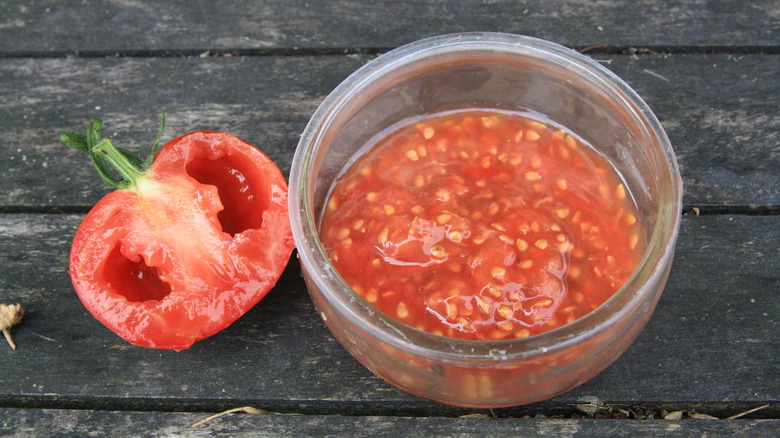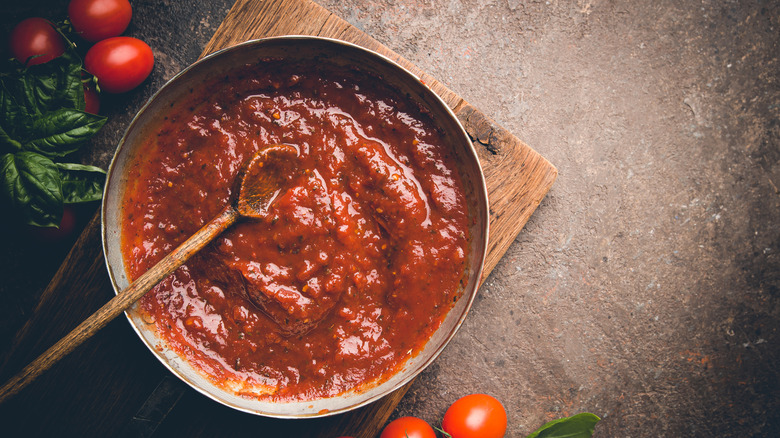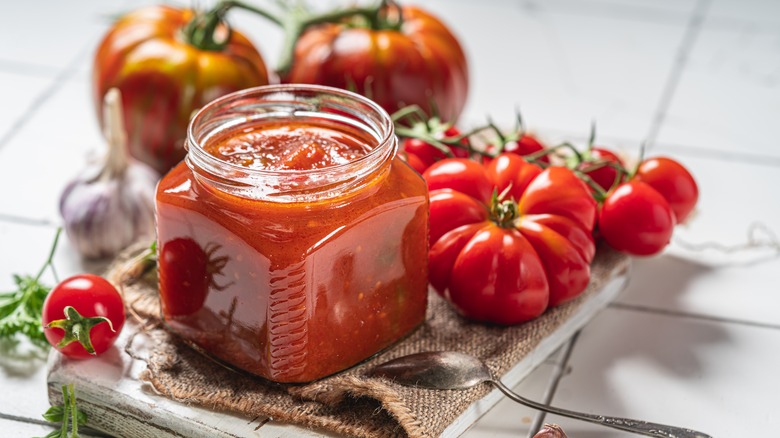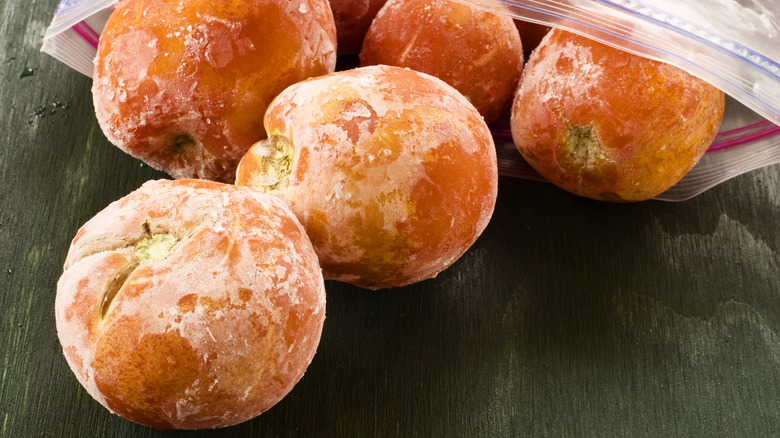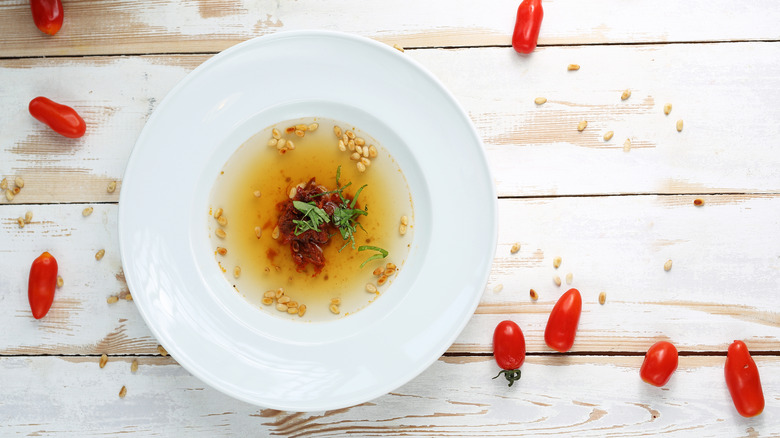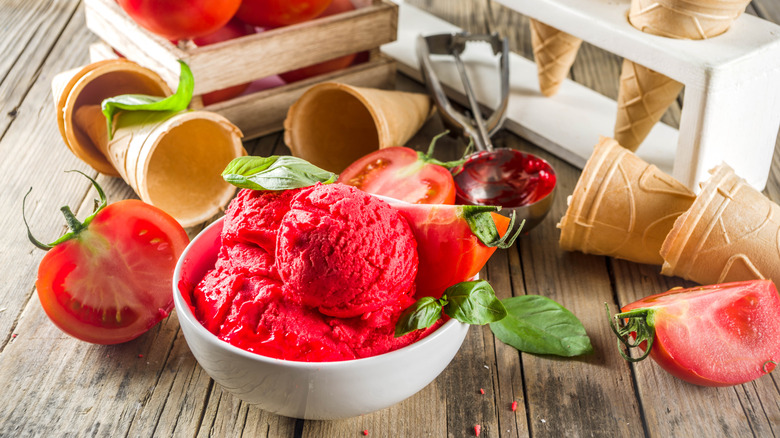14 Mistakes Everyone Makes When Cooking Tomatoes, According To A Chef
Cultivated by Mesoamerican people and brought to Europe during the Columbian Exchange in the 16th century, tomatoes (Solanum lycopersicum) have long been an integral ingredient of culinary traditions across the globe. They are valued for their versatility and many nutritional benefits associated with abundant antioxidants, like lycopene and beta-carotene, fiber, vitamin C, potassium, folate, and more.
Botanically a fruit, more specifically a berry, and with over 10,000 varieties, this plant is generally prepared as a vegetable. It was legally classified as a vegetable by the U.S. Supreme Court in 1893, further adding to the confusion as to its botanical and culinary classification.
Regardless of how you use tomatoes in your favorite recipes, there are some pitfalls that you should be aware of when selecting, preparing, and cooking them. That is where I come in. As the chef and owner of a fine-dining restaurant that focused on Mediterranean cuisine and sourced many of its ingredients from local farms for nearly 18 years, tomatoes were one of the go-to ingredients in my culinary arsenal. I have used my expertise and experience to compile a list of common mistakes everyone makes when cooking tomatoes.
1. Only using supermarket tomatoes
One of the benefits of living in a world where we can run to the grocery store any time and purchase virtually anything we want is that we can find tomatoes year-round. That said, the options for store-bought tomatoes are relatively limited in scope and quality. Typically, the store will have hybrid varieties bred to have thicker skin, be more durable, be more homogeneous in proportions, and be more pest- and blight-resistant. While this is ideal for safely transporting these fruits from farm to store, it yields a product that often lacks flavor and texture.
The solution is to consider purchasing heirloom tomatoes at the farmer's market, at a specialty grocer, or directly from the farm. Heirloom tomatoes are non-hybrid varieties grown from seed rather than hand-pollinated. These tomatoes are more diverse in color, texture, and flavor, having thinner skin and juicier flesh. Because each tomato plant grows fewer pieces of fruit, heirloom tomatoes can also come at a premium price. When in season, they cannot be beaten, especially if you plan to eat your tomatoes raw. To save money, I recommend asking your local farmer if they have what are known as ugly fruits, meaning ones with blemishes, often sold at a discounted price.
2. Not knowing when tomatoes are fully ripe
Whether you purchase a tomato from the grocery store or a farmer's market, it is crucial to know when it is ripe before you use it in a recipe. When a tomato is ripe, it will have a delightful aroma, be heavy for its weight, and have a firm but supple texture that will give when you press it between your thumb and index finger. It will also change color from pale green to red, yellow, orange, or whatever is natural for that variety.
Tomatoes are considered climacteric fruits, meaning they will continue to ripen after they have been harvested. This means you can purchase an unripened tomato and ripen it at home by storing it alongside other climacteric fruits that produce ethylene gas as they ripen, like bananas. Once a tomato is ripe, use it within a day or two for maximum flavor and texture. You can extend its life expectancy by transferring the ripe tomato to the refrigerator. The cold temperature will halt the ripening process. This may slightly affect the texture, but the fruit remains flavorful. Take it out of the fridge and allow it to sit for 30 minutes before using it in a recipe.
3. Never using green tomatoes
I know I just said not to cook with unripe tomatoes, but there is a time and place for using them. Indeed, anyone who has ever grown tomatoes knows that at some point in the summer, you will end up with a bumper crop of green tomatoes that you couldn't use quickly enough. This is an opportunity to get creative with learning how to tame those tart tomatoes and turn them into something delicious.
Unripe green tomatoes can be delightful in recipes from salads to pies, pizza, and more. While fried green tomatoes are the most common go-to dish for these verdant beauties, another clever method of tempering their tanginess is to take a cue from zucchini and put them into a quick bread. The sugar will mellow the tomatoes, while spices will bring warmth and depth. And if you prefer something zesty that will make your mouth pucker and brighten any meal, try turning them into pickles. These are the perfect condiments to add to your next Mexican fiesta or to temper the heat of spicy Indian curry.
4. Cutting with the wrong knife
The slightly firm skin and tender, juicy flesh of the inside of a tomato make it challenging to cut without using the correct tool. While you can buy a fancy tomato knife, there is no need to spend money on a separate kitchen gadget that will clutter up your drawers. A serrated knife, bread knife, or freshly sharpened chef's knife will suffice.
As celebrity chef Alex Guarnaschelli suggests, a good rule of thumb for slicing tomatoes is to turn them onto their side before hacking into them. This amplifies the flavor of tomatoes and their capacity to absorb other ingredients in a dish. It also makes breaking tomatoes down into smaller chunks somewhat more efficient, allowing easy access to eliminating seeds and scooping out the fibrous core of heftier fruits.
Another good hack for handling tomatoes, particularly whole peeled canned ones you plan to use in sauce, is to follow the lead of chef Giada De Laurentiis and employ your sturdiest kitchen shears. This eliminates the need for using your hands to break them up, which can be painful if you don't realize you have any nicks or cuts and is labor intensive.
5. Not peeling tomatoes
In some cases, like with sauces, salsas, and soups, tomato skins can yield less than ideal results. They can be challenging to chew, slightly acrid, and difficult to blend into a smooth texture. If you plan to can tomatoes, the skins can harbor potentially hazardous pathogens that can lead to foodborne illness. For all of these reasons, it is worthwhile to take the time to peel your tomatoes ahead of using them in your favorite recipes.
The standard method for peeling tomatoes is to blanch them by submerging them in boiling water for 30 to 60 seconds and then transferring them to an ice water bath. The skins will slip right off. You can also pop the tomato into the microwave for a few seconds at a time until the skin begins to soften. Just be sure to score the tip of the tomato with a knife to prevent it from exploding in the microwave, and do not overcook it, or its texture will become mushy. Lastly, if all of this sounds like too much effort, you can cut your tomato in half and shred it using a box grater to remove the skin.
6. Skipping the salt
While tomatoes are delicious right off the vine, one ingredient can make them even more tasty: salt. Salt is the key to heightening the experience of eating tomatoes for a few reasons. First, it helps reduce the fruit bitterness while making it seem sweeter. It also helps draw moisture out of the fruit, which has a couple of benefits, from enhancing its aroma to reducing its capacity to water down other ingredients in recipes where you plan to use the tomatoes at a later time. Lastly, salt can enhance the eating experience by awakening your salivary glands and making your mouth water.
Consider using sea salt for best results when salting tomatoes for immediate consumption. If you are feeling particularly fancy, flavored salts, like smoked sea salt or truffle salt, can create nuance and juxtapose the acidity of the tomatoes. If you are salting tomatoes to reduce their moisture for a sauce or salsa, sprinkle them with kosher salt and allow them to sit for about 15 minutes before draining them. Approximately one teaspoon of salt per pound of tomatoes will suffice. And make sure you don't forget to reserve the strained tomato liquid.
7. Avoiding canned tomatoes
While some recipes require fresh tomatoes, like that Caprese salad or pico de gallo, others can effortlessly and affordably be made with canned tomatoes. Canned tomatoes aren't just convenient and cost-effective, but they are also nutritious. Contrary to popular belief, while canned tomatoes may suffer some nutrient loss of water-soluble vitamins, they benefit nutritionally from the canning process. Canned tomatoes make the antioxidant lycopene more bioavailable, meaning it is more readily absorbed and put to use within your body. This antioxidant has been linked to many health benefits, from reducing the risk of heart disease and cancer to regulating diabetes. The key is to obtain "no salt added" tomatoes and season them yourself.
Though there are different types of canned tomatoes, from stewed to whole peeled to diced, each with a distinct flavor profile, generally speaking, canned tomatoes have a richer, more robust, umami-forward flavor than fresh ones. This is particularly desirable in many recipes, like sauces, soups, and slow-cooked stews. Canned tomatoes also eliminate the necessity of blanching and peeling them. If you can find them, I prefer fire-roasted canned tomatoes. They have a hint of smokiness and added savoriness, providing even more complexity to any recipe.
8. Using the wrong cookware
You are already aware of reactive versus non-reactive cookware if you have prepared a slow-cooked marinara or ragu in your cast-iron Dutch oven and noticed a peculiar metallic aftertaste in the finished dish and discoloring in the pan. Certain types of cookware, like carbon steel, unfinished cast iron, unlined copper, and aluminum, will experience chemical reactions when used to cook highly alkaline or acidic foods, such as tomatoes. When this occurs, it can damage the pan, causing metals to seep into your food and taste unpleasant.
For best flavor and results, when cooking tomatoes, particularly slow-cooked recipes like sauces and soups, it is always best to opt for non-reactive cookware, such as stainless steel, non-stick pans, or enameled cast iron. While there may be some mild risk of toxicity associated with consuming tomato-based recipes cooked in reactive cookware, the likelihood of ingesting enough metal to make you ill is unlikely, according to McGill University's Office for Science and Society. That said, it is better to be safe than sorry, and you don't want to compromise on the quality of your dish when you have put in the time and effort to create a delicious tomato sauce.
9. Not removing the seeds
Depending on the size and variety, tomatoes can be more or less seedy. Though you can purchase seedless varieties to grow, Romas are always a good option if you want a tomato with fewer seeds per fruit. There are differing opinions regarding seeding fresh tomatoes for use in recipes. In my opinion, certain circumstances will benefit markedly in flavor and texture when the seeds are removed.
Removing the seeds is advisable when making salads and salsas or adding them to a casserole or egg dish. The seeds can impart a more bitter flavor while increasing the moisture content within the dish, causing it to become soggy or mushy. If you cook tomatoes into a sauce, stew, soup, or other slow-cooked dish, you can save yourself the effort of seeding them. The seeds will add more depth of flavor to the recipe and can be easily incorporated by puréeing the dish. To seed a tomato, cut it in half and gently pry the seeds out of the fruit with your fingers or a teaspoon. You will want to strain the seeds and save the liquid for later use.
10. Not adding baking soda to sauce
Many of us grew up witnessing our grandmothers adding a spoonful of sugar to homemade tomato sauce or soup. This was likely to help mitigate the acidity of tomatoes, which can overpower delicate sauces and soups. While this technique works, there is a much better option that will enhance the other flavor elements of the tomato without adding extra sugar. The key to the most flavorful and least acidic sauce is to toss in some baking soda. Just a tiny amount of baking soda, less than a quart of a teaspoon per batch of sauce or soup, can help transform the recipe, nullifying the acid and amplifying the inherent sweetness of the tomatoes.
To further balance the acidity of tomato-based sauces and soups, use canned varieties naturally lower in pH, such as San Marzano or similar domestically produced Romas. Just be careful to get the real deal if purchasing San Marzanos. There are a lot of imposters out there charging a hefty premium for an inauthentic product. Real San Marzanos should be labeled with the DOP seal and have a stamp on the bottom of the can indicating the Consorzio San Marzano certification number and origin of the tomatoes.
11. Choosing the wrong tomato for the job
While it may seem like you can use any tomato for any recipe, with thousands of varieties available and each having distinct characteristics from flavor and texture to acidity level and seed content, some guidelines should be observed when choosing the right tomato for a particular recipe. Opt for Romas, heirloom varieties, or tomatoes on the vine when making a sauce or soup. These have lower acidity levels, fewer seeds, firmer flesh, and more savory flavor.
For fresh applications, like salsa or gazpacho, plum tomatoes are always a good option, particularly Romas, due to their meaty texture and lower seed content. That said, don't be shy about using any variety of heirloom tomatoes. These typically have more subtle, nuanced flavors and diverse, beautiful colors that can make your dish visually stunning, and we all know we eat with our eyes first. Campari, grape, or cherry tomatoes are always a good bet for salads as they are more bite-sized. These are also ideal for tarts and pizzas. Lastly, if you are searching for the ultimate slicing tomato for a BLT, look no further than a firm-fleshed beefsteak tomato.
12. Not freezing tomatoes
When that bumper crop of tomatoes hits at the end of summer, you will want options for using all that bounty. No matter how much you preserve in cans, juice, pickle, turn into salsa, make into marinara, or eat, you will likely still have tomatoes left over. The solution is to freeze them. Frozen tomatoes can be fabulous in any recipe where they are cooked, from soups to sauces to stews. They are not ideal for consuming raw as the moisture within the tomato forms into ice crystals, breaking down the fruit's cell walls and softening its texture.
There are many recommendations for freezing tomatoes that require varying degrees of effort. Some suggest pre-blanching, peeling, or seeding the fruit before tossing it in a freezer. None of this is necessary. Wash the fruit well, remove blemishes, and seal it in a freezer bag. Once the fruit is thawed, the skins will peel right off, and the tomatoes are softened so you can add them straight into the pot after crushing them or snipping them with scissors. If I know I am making sauce, I prefer these frozen tomatoes. They are far easier to deal with and have a delicious flavor.
13. Failing to save the tomato water
Remember how I kept telling you to save that tomato water after seeding tomatoes or salting them? Here is the reason why: tomato water is liquid gold. While excess moisture can adversely affect some recipes, particularly salads, that liquid has flavor, a hint of acidity, and a crimson hue that can impart visual appeal in many recipes.
Perhaps the most common use for tomato water is in cocktails. It is the perfect alternative for a refreshing iteration of a bloody mary or red snapper, substituting for the thick, rich tomato juice. It is also commonly transformed into soups, sauces, and dressings.
A more unusual yet equally delightful use for tomato water is as a base for a delectable sorbet. Remember, tomato is a fruit, and if treated properly, its inherent sweetness can easily be coaxed out of it, making it the perfect addition to desserts. You can also create a savory tomato sorbet infused with spices, vinegar, and olive oil to scoop atop fresh mozzarella for a spin on a Caprese that will knock your socks off.
14. Always cooking tomatoes the same way
Speaking of unusual recipes, while there are many tried and true recipes for preparing tomatoes, like marinara, soup, salsa, and salads, do not let tradition hinder the hidden potential of the tomato. It is worth taking a hint from other cultures and flexing your culinary muscles to incorporate tomatoes into recipes using alternative cooking methods, from roasting and grilling to air frying and dehydrating them.
Roasting, grilling, and air-frying tomatoes all achieve similar results. They evaporate excess moisture, develop a firmer, meaty texture, amplify rich, savory, umami flavors, and blister the outside of the tomato, conferring a hint of smokiness that completely transforms them. These are great as a side dish or can be converted into a more robust sauce, soup, or salsa.
Another quirky yet delicious use for tomatoes is turning them into salt. This is a marvelous way to repurpose the discarded skins of the tomatoes you peeled for your sauce. Dehydrate and whizz them together in a coffee grinder or food processor along with kosher salt. Use this magic salt to season your Caprese salad, enhance the tomato flavor in your marinara, or season chicken or fish after pan-searing or grilling it as a finishing salt.
